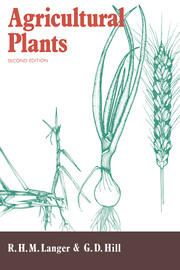Book contents
- Frontmatter
- Contents
- Preface to the first edition
- Preface to the second edition
- 1 World population and crop production
- 2 Plant structure
- 3 Liliaceae
- 4 Poaceae
- 5 Apiaceae
- 6 Asteraceae
- 7 Brassicaceae
- 8 Cannabinaceae
- 9 Chenopodiaceae
- 10 Cucurbitaceae
- 11 Fabaceae
- 12 Lamiaceae
- 13 Linaceae
- 14 Malvaceae
- 15 Papaveraceae
- 16 Solanaceae
- 17 Physiological basis of yield
- Index of specific names
- Subject index
7 - Brassicaceae
Published online by Cambridge University Press: 05 June 2012
- Frontmatter
- Contents
- Preface to the first edition
- Preface to the second edition
- 1 World population and crop production
- 2 Plant structure
- 3 Liliaceae
- 4 Poaceae
- 5 Apiaceae
- 6 Asteraceae
- 7 Brassicaceae
- 8 Cannabinaceae
- 9 Chenopodiaceae
- 10 Cucurbitaceae
- 11 Fabaceae
- 12 Lamiaceae
- 13 Linaceae
- 14 Malvaceae
- 15 Papaveraceae
- 16 Solanaceae
- 17 Physiological basis of yield
- Index of specific names
- Subject index
Summary
The Brassicaceae (Cruciferae) derive their old name from the shape of their flower which is said to be cruciform or resembling a cross when looked at from above. This family consists of some 300 genera and 3000 species, mainly herbaceous plants occurring predominantly in temperate regions. The genus of the greatest economic importance is Brassica, which will need to be described in some detail, but there are two or three other genera deserving at least a mention.
BRASSICA
There are about 40 species in this genus, most of them annual or biennial, several of them cultivated extensively in cool, temperate regions. Plants belonging to this genus usually have tap roots, and there is a tendency for storage organs of various kinds to be developed. The stems are erect, although internodes are often greatly foreshortened while the plant remains vegetative, the leaves are alternate, lobed, and glabrous or covered with simple hairs. The inflorescence is a raceme bearing numerous, conspicuous flowers, usually yellow in colour. There are four sepals, arranged as an inner and an outer pair, and four petals each consisting of a narrow, erect claw at the base with a broad, spreading limb above, together forming the configuration of a cross (Fig. 7.1). The six stamens are represented by a relatively short outer pair and four somewhat longer inner ones. The ovary is superior and consists of two united carpels divided by a membranous, false septum and a single, lobed stigma.
- Type
- Chapter
- Information
- Agricultural Plants , pp. 168 - 189Publisher: Cambridge University PressPrint publication year: 1991

